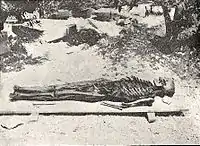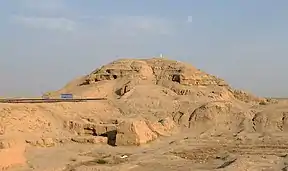Tabnit
Tabnit (Phoenician: 𐤕𐤁𐤍𐤕 TBNT) was the Phoenician King of Sidon c. 549–539 BC.[1] He was the father of King Eshmunazar II.
Tabnit | |
|---|---|
 | |
| Allegiance | Achaemenid Empire |
| Years of service | c. 549 BC – c. 539 BC |
| Rank | King of Sidon |
| Spouse(s) | Amoashtart (also his sister) |
| Children | Eshmunazar II |
| Relations | Amoashtart (sister) unnamed brother Bodashtart (nephew) Yatonmilk (grandnephew) |

He is well known from his sarcophagus, decorated with two separate and unrelated inscriptions – one in Egyptian hieroglyphics and one in Phoenician script. It was created in the 6th century BC, and was unearthed in 1887 by Osman Hamdi Bey at the Ayaa Necropolis near Sidon together with the Alexander Sarcophagus and other related sarcophagi. Tabnit's body was found floating in the original embalming fluid and almost perfectly preserved, save for the face and neck which were not submerged, but Bey's men spilled all the fluid and left the body to rot in the desert sun, at which point it quickly decomposed to little more than bones and withered viscera.[2][3] Both the sarcophagus and Tabnit's decomposed skeleton are now in the Istanbul Archaeology Museums.[4]
The sarcophagus, together with the Sarcophagus of Eshmunazar II, was possibly acquired by the Sidonians following their participation in the Battle of Pelusium (525 BC),[5] and served as models for later Phoenician sarcophagi.[6]
Dating
Both the Tabnit sarcophagus and the Sarcophagus of Eshmunazar II are thought to originally date from the Twenty-sixth Dynasty of Egypt, which had its capital at Sais.[6] This is partially due to their resemblance to similar sarcophagi such as the Psamtik II-era Horkhebit sarcophagus from Saqqara, now in the Metropolitan Museum of Art.
 Skeleton of king Tabnit
Skeleton of king Tabnit._2_sides._Paris%252C_1892.jpg.webp) Head of king Tabnit
Head of king Tabnit
Notes
- Elayi 2006.
- Torrey 1902, pp. 168–9 (footnote): "When the sarcophagus of Tabnit was exhumed, in the year 1887, and the lid was removed, the body of the king was found to be in a very good state of preservation. It was lying in a brownish-colored, somewhat "oily" fluid, which nearly filled the sarcophagus. The eyes were gone; the nose, lips, and the most prominent part of the thorax, which had not been covered by the liquid, had decayed away; in other respects, however, the corpse was like that of a man only recently buried. It was but slightly emaciated; plenty of flesh remained on both face and limbs, and the skin was soft to the touch. The vital organs and viscera had not been removed (a note-worthy circumstance), and were perfectly preserved. Dr. Shibly Abela, of Sidon, a physician of education and experience, remarked that the face showed traces of small-pox; it was not apparent, however, that the king had died of that disease. The color of the skin was described as somewhat "coppery," the tinge being perhaps due to the influence of some substance, or substances, held in solution by the enveloping fluid. The fluid itself may have been partly, or even wholly, rain-water, which finds its way into most of the tombs about Sidon; but in any case it is evident, from the facts just given, that the body of the king had been skilfully embalmed. I do not know that any similar case has ever been observed and reported. After the body had been removed from the sarcophagus and exposed to the sun. it decomposed and shrunk to withered skin and bones in a very short time. My chief authority for these facts is the Rev. William K. Eddy, of Sidon, a keen observer and cautious reporter, who was one of the few who saw and touched the body of Tabnit when it was first exposed to view. Mr. Eddy was positive in his opinion that the king, at the time of his death, had not passed middle life; the face, he thought, was that of a man of less than fifty years of age."
- Gubel, Eric (2003), "Phönizische Anthropoide Sarkophage by Katja Lembke", Bulletin of the American Schools of Oriental Research, 332: 98–100, doi:10.2307/1357812, JSTOR 1357812
- İstanbul Archaeological Museums
- Nitschke 2007, p. 71: "Three of these Egyptian sarcophagi manufactured during the twenty-sixth dynasty were apparently acquired by the Sidonians, perhaps as a result of Phoenician participation in Cambyses’ conquest of Egypt in 525 B.C."
- Nitschke 2007, p. 72.
References
- Elayi, Josette (2006). "An updated chronology of the reigns of Phoenician kings during the Persian period (539–333 BCE)" (PDF). Digitorient. Collège de France – UMR7912. Archived from the original (PDF) on 2020-07-30.
- Hamdi Bey, Osman; Reinach, Théodore (1892), Une nécropole royale à Sidon [A royal necropolis in Sidon] (in French) (editio princeps)
- Hamdi Bey, Osman; Reinach, Théodore (1892), Une nécropole royale à Sidon: fouilles: Planches [A royal necropolis in Sidon: excavations] (in French) (Plates)
- Jessup, Henry Harris (1910), Fifty-Three Years In Syria, vol. 2, Fleming H. Revell Company, p. 507
- Gottheil, Richard (1889), "The Inscription of Tabnit", Hebraica, 5 (2): 197, doi:10.1086/369051, JSTOR 527253
- Bommas, Martin (2006), "Die hieroglyphischen Texte auf dem Sarg des Tabnit" [The hieroglyphic texts on the Sarcophagi of Tabnit], Orientalia, 75 (1): 15
- Assmann, Jan, "Zur Baugeschichte der Königsgruft von Sidon" [The construction history of the royal tomb of Sidon] (PDF), Archäologischer Anzeiger: 690–716
- Nitschke, Jessica (2007), Perceptions of Culture:Interpreting Greco-Near Eastern Hybridity in the Phoenician Homeland (Ph.D.), University of California, Berkeley
- Torrey, Charles (1902), "A Phoenician Royal Inscription", Journal of the American Oriental Society, 23: 156–173, doi:10.2307/592387, JSTOR 592387

